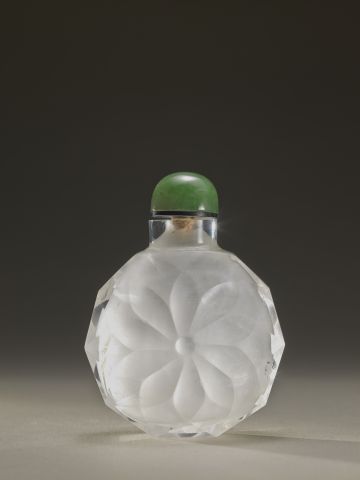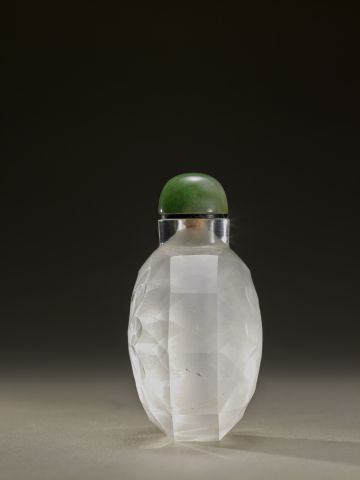

Bottle ID: 703
FACETED FLOWER-HEAD
Date: 1750-1860
Height: 55 mm
Crystal, very well hollowed, with frosted interior, of decagonal faceted form, with a cylindrical neck, the convex main sides each carved as a flower-head with radiating petals.
Possibly imperial, attributed to the Palace Workshops, Beijing
Similar Examples:
Hugh Moss, Victor Graham and Ka Bo Tsang, A Treasury of Chinese Snuff Bottles. The Mary and George Bloch Collection, Volume 2, Hong Kong, 1998, pp.426-429, no. 337
Stevens, Bob C. The Collector's Book of Snuff Bottles, 1976, p. 282, no. 1009 (blue jadeite)
Sotheby's New York, September 22, 1995, lot 88 (white nephrite)
White, Helen. Snuff Bottles from China. The Victoria and Albert Museum Collection, 1992, pp. 70-71, pl. 28, no. 1 (agate) and pp. 98-99, pl. 42, no.s 2 and 3
Provenance:
Sotheby's Hong Kong, November 24th, 2014, lot 31
The Collection of Mary and George Bloch
Chinese Porcelain Company, New York, 1991
The Hon. Irene Austin, The Fernhill Park Collection, formed between 1944 and 1947
Exhibited:
Chinese Porcelain Company, New York, October, 1991
Hong Kong Museum of Art, Hong Kong, March-June 1994
National Museum of Singapore, Singapore, November, 1994-February, 1995
Published:
Chinese Snuff Bottles from the Fernhill Park Collection. Chinese Porcelain Co., New York, 1991, p.39, no. 164
Robert Kleiner, Yang Boda and Clarence F. Shangraw. Chinese Snuff Bottles, A Miniature Art from the Collection of George and Mary Bloch, Hong Kong Museum of Art, Hong Kong, 1994,p. 263, no. 204
Robert Kleiner. Chinese Snuff Bottles, The Mary and George Bloch Collection. Hong Kong Museum of Art, Oriental Art, Spring 1994, p. 36
Hugh Moss, Victor Graham and Ka Bo Tsang, A Treasury of Chinese Snuff Bottles. The Mary and George Bloch Collection, Volume 2, Hong Kong, 1998, pp.147-149, no. 235, The Flower at Court Crystal
Faceted bottles, predominately in glass, but also jade and hardstones, were a novelty of Palace production from the eighteenth century onwards and lasting as a style until the mid-nineteenth century. It appears that stylistically bottles became larger and more complex in design as the nineteenth century wore on, resulting in examples such as this one in crystal with its ten sides and abstract radiating flower petals. It is impossible to identify which flower the design is based on, but given the courtly symbolism attached to certain flowers, it is likely that it was originally derived from either the peony or the chrysanthemum, the former being associated with wealth and honor and the latter with longevity. Despite its likely nineteenth century date, the bottle has been produced with much care; it is thinly hollowed yet with concavity given to the petals, and with limited internal polishing to give the bottle a frosted opacity. This is clearly deliberate as the two similar crystal examples in the Victoria and Albert Museum Collection are also left with a slightly roughened interior giving the same opacity. Interestingly those two bottles, which were in the museum by 1895, both have private hallmarks on their bases, probably refering to specific scholars' studios, one reading: Jing zhai and the other Shou chun lou ji.
< Back to full list
 English
English 中文
中文